Mission&Vision
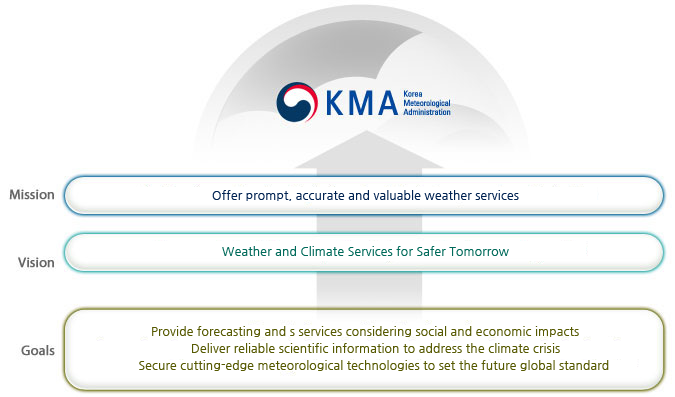
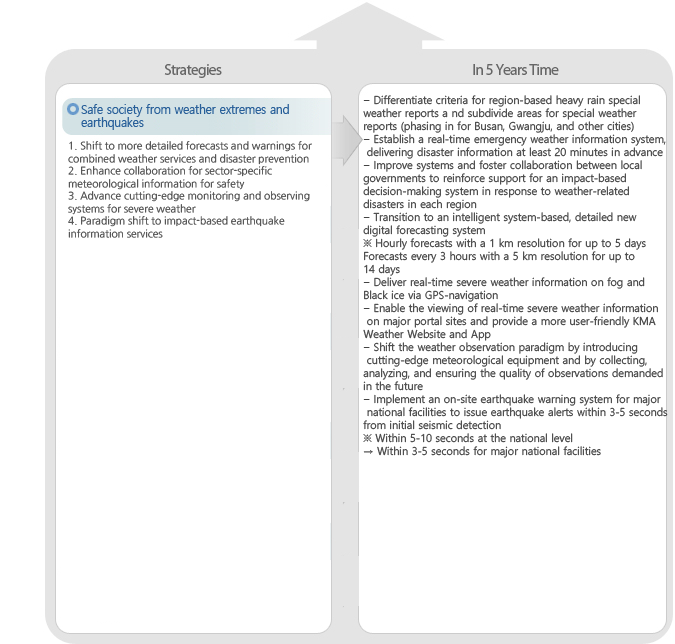
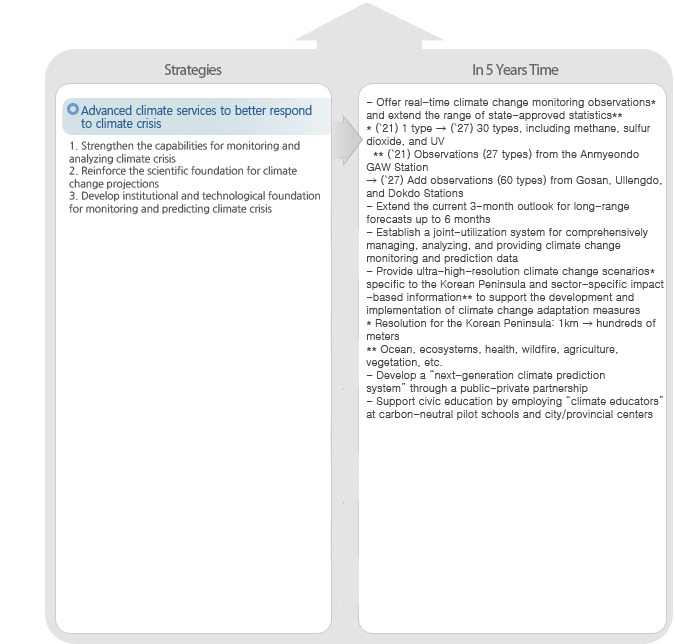
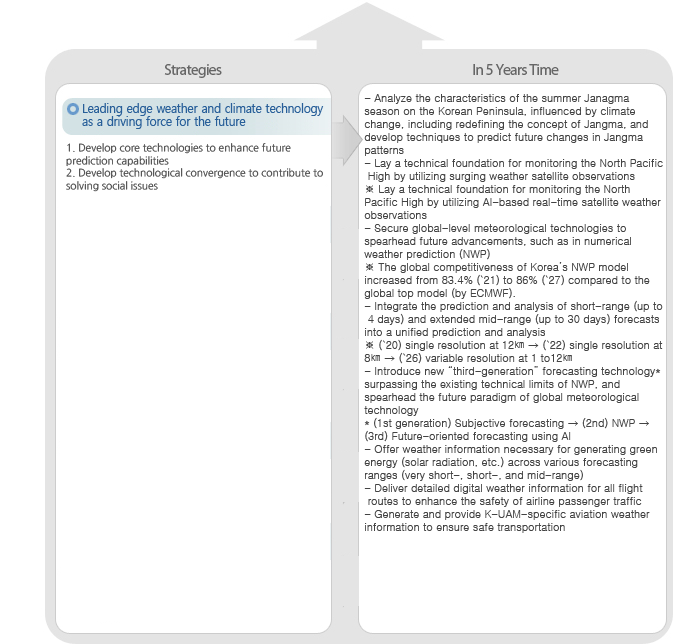
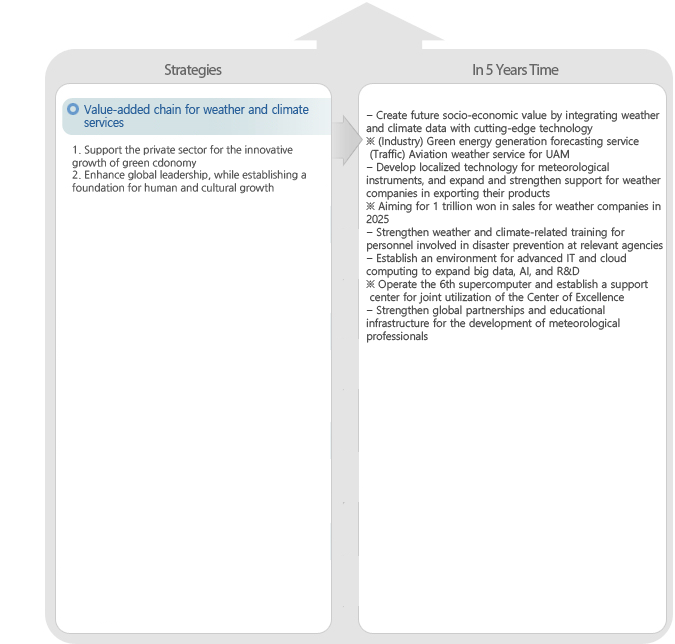
Mission
- Offer prompt, accurate and valuable weather servicesVision
- Weather and Climate Services for Safer TomorrowGoals
- Provide forecasting and s services considering social and economic impacts- Deliver reliable scientific information to address the climate crisis
- Secure cutting-edge meteorological technologies to set the future global standard
Strategies
Safe society from weather extremes and earthquakes1.Shift to more detailed forecasts and warnings for combined weather services and disaster prevention
2.Enhance collaboration for sector-specific meteorological information for safety
3.Advance cutting-edge monitoring and observing systems for severe weather
4.Paradigm shift to impact-based earthquake information services
Advanced climate services to better respond to climate crisis
1.Strengthen the capabilities for monitoring and analyzing climate crisis
2.Reinforce the scientific foundation for climate change projections
3.Develop institutional and technological foundation for monitoring and predicting climate crisis
Leading edge weather and climate technology as a driving force for the future
1.Develop core technologies to enhance future prediction capabilities
2.Develop technological convergence to contribute to solving social issues
Value-added chain for weather and climate services
1.Support the private sector for the innovative growth of green cdonomy
2.Enhance global leadership, while establishing a foundation for human and cultural growth
In 5 Years Time
- Differentiate criteria for region-based heavy rain special weather reports and subdivide areas for special weather reports (phasing in for Busan, Gwangju, and other cities)- Establish a real-time emergency weather information system, delivering disaster information at least 20 minutes in advance
- Improve systems and foster collaboration between local governments to reinforce support for an impact-based decision-making system in response to weather-related disasters in each region
- Transition to an intelligent system-based, detailed new digital forecasting system
* Hourly forecasts with a 1 km resolution for up to 5 days
Forecasts every 3 hours with a 5 km resolution for up to 14 days
- Deliver real-time severe weather information on fog and Black ice via GPS-navigation
- Enable the viewing of real-time severe weather information on major portal sites and provide a more user-friendly KMA Weather Website and App
- Shift the weather observation paradigm by introducing cutting-edge meteorological equipment and by collecting, analyzing, and ensuring the quality of observations demanded in the future
- Implement an on-site earthquake warning system for major national facilities to issue earthquake alerts within 3-5 seconds from initial seismic detection
* Within 5-10 seconds at the national level → Within 3-5 seconds for major national facilities
- Offer real-time climate change monitoring observations* and extend the range of state-approved statistics**
* (`21) 1 type → (`27) 30 types, including methane, sulfur dioxide, and UV
** (`21) Observations (27 types) from the Anmyeondo GAW Station
→ (`27) Add observations (60 types) from Gosan, Ullengdo, and Dokdo Stations
- Extend the current 3-month outlook for long-range forecasts up to 6 months
- Establish a joint-utilization system for comprehensively managing, analyzing, and providing climate change monitoring and prediction data
- Provide ultra-high-resolution climate change scenarios* specific to the Korean Peninsula and sector-specific impact-based information** to support the development and implementation of climate change adaptation measures
* Resolution for the Korean Peninsula: 1km → hundreds of meters
** Ocean, ecosystems, health, wildfire, agriculture, vegetation, etc.
- Develop a “next-generation climate prediction system” through a public-private partnership
- Support civic education by employing “climate educators” at carbon-neutral pilot schools and city/provincial centers
- Analyze the characteristics of the summer Janagma season on the Korean Peninsula, influenced by climate change, including redefining the concept of Jangma, and develop techniques to predict future changes in Jangma patterns
- Lay a technical foundation for monitoring the North Pacific High by utilizing surging weather satellite observations
※ Lay a technical foundation for monitoring the North Pacific High by utilizing AI-based real-time satellite weather observations
- Secure global-level meteorological technologies to spearhead future advancements, such as in numerical weather prediction (NWP)
※ The global competitiveness of Korea’s NWP model increased from 83.4% (`21) to 86% (`27) compared to the global top model (by ECMWF).
- Integrate the prediction and analysis of short-range (up to 4 days) and extended mid-range (up to 30 days) forecasts into a unified prediction and analysis
※ (`20) single resolution at 12㎞ → (`22) single resolution at 8㎞ → (`26) variable resolution at 1 to12㎞
- Introduce new “third-generation” forecasting technology* surpassing the existing technical limits of NWP, and spearhead the future paradigm of global meteorological technology
* (1st generation) Subjective forecasting → (2nd) NWP → (3rd) Future-oriented forecasting using AI
- Offer weather information necessary for generating green energy (solar radiation, etc.) across various forecasting ranges (very short-, short-, and mid-range)
- Deliver detailed digital weather information for all flight routes to enhance the safety of airline passenger traffic
- Generate and provide K-UAM-specific aviation weather information to ensure safe transportation
- Create future socio-economic value by integrating weather and climate data with cutting-edge technology
※ (Industry) Green energy generation forecasting service
(Traffic) Aviation weather service for UAM
- Develop localized technology for meteorological instruments, and expand and strengthen support for weather companies in exporting their products
※ Aiming for 1 trillion won in sales for weather companies in 2025
- Strengthen weather and climate-related training for personnel involved in disaster prevention at relevant agencies
- Establish an environment for advanced IT and cloud computing to expand big data, AI, and R&D
※ Operate the 6th supercomputer and establish a support center for joint utilization of the Center of Excellence
- Strengthen global partnerships and educational infrastructure for the development of meteorological professionals







